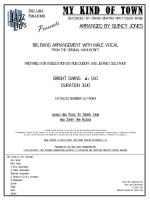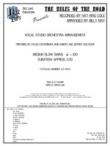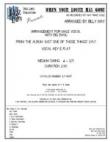MY KIND OF TOWN [DOWNLOAD]
Recorded by Frank Sinatra
Arranged by Billy May, Adapted by Quincy Jones, Prepared for Publication by Rob DuBoff and Jeffrey Sultanof

Cat #: JLP-9083-DL
$75.00This product is available for immediate download after purchase.
Questions?
Please call +1-518-587-1102 or email us.
Edition: Jazz Big Band Arrangement with Vocal
Description: Swing - Difficult
Publisher: Jazz Lines Publications
My Kind of Town was composed by Jimmy Van Heusen with lyrics by Sammy Cahn. The song was originally written for Robin and the 7 Hoods, a 1964 musical film starring several members of the Rat Pack. Sinatra first recorded this song in 1964, conducted by Nelson Riddle. But, it is very likely that the arrangement was actually done by Billy May. The arrangement used for the 1965 summer tour with the Count Basie Orchestra and performance and recording at the Sands Hotel the following year was an adaptation created by Quincy Jones.
It would be pretty hard for a three-way collaboration between Frank Sinatra, Quincy Jones, and the Count Basie Orchestra to not produce outstanding results. This version of My Kind of Town somehow still manages to exceed expectations, with the three stars each finding a way to shine both alongside each other and in their own rights.
A smoothly flowing intervallic melody weaves its way for an introduction before Sinatra's arrival at measure 5. The verse is taken in a rubato fashion that will seem to be slower-paced than it actually is. Eventually, the time settles into a steady medium swing at measure 21 for the main melody. The horn backgrounds are rather densely written, often with multiple figures going on at the same time, so be sure that your horn players are aware of how they fit into things. To add even more fun, Harry 'Sweets' Edison provides some typically tasty trumpet fills throughout the entire performance. The rhythm section serves as the constant, exemplified by Sonny Payne's relentlessly swinging groove.
The band gets to shine for a moment during a rhythmically driving interlude at measure 51. This interlude sets up a key change for Sinatra's return at measure 59. While the performance already has an air of intensity to it, things continue to build up even more from here on out, reflected by both the business of the ensemble and yet another key change at measure 75. Everything comes to a climax at measure 99, where Sinatra finds himself shouting atop a hard-riffing ensemble before everything comes together for a (rather familiar) concluding unison lick.
This publication was prepared using Quincy Jones's original pencil score - this is not a transcription.
2 Alto Saxophones (Alto Sax 2 Doubles on Flute)
2 Tenor Saxophones
Baritone Saxophone
5 Trumpets
4 Trombones
Guitar
Piano
Bass
Drum Set
Trumpets 1 and 2: Eb6
Trumpet 5: E6
Trombone 1: Db5










